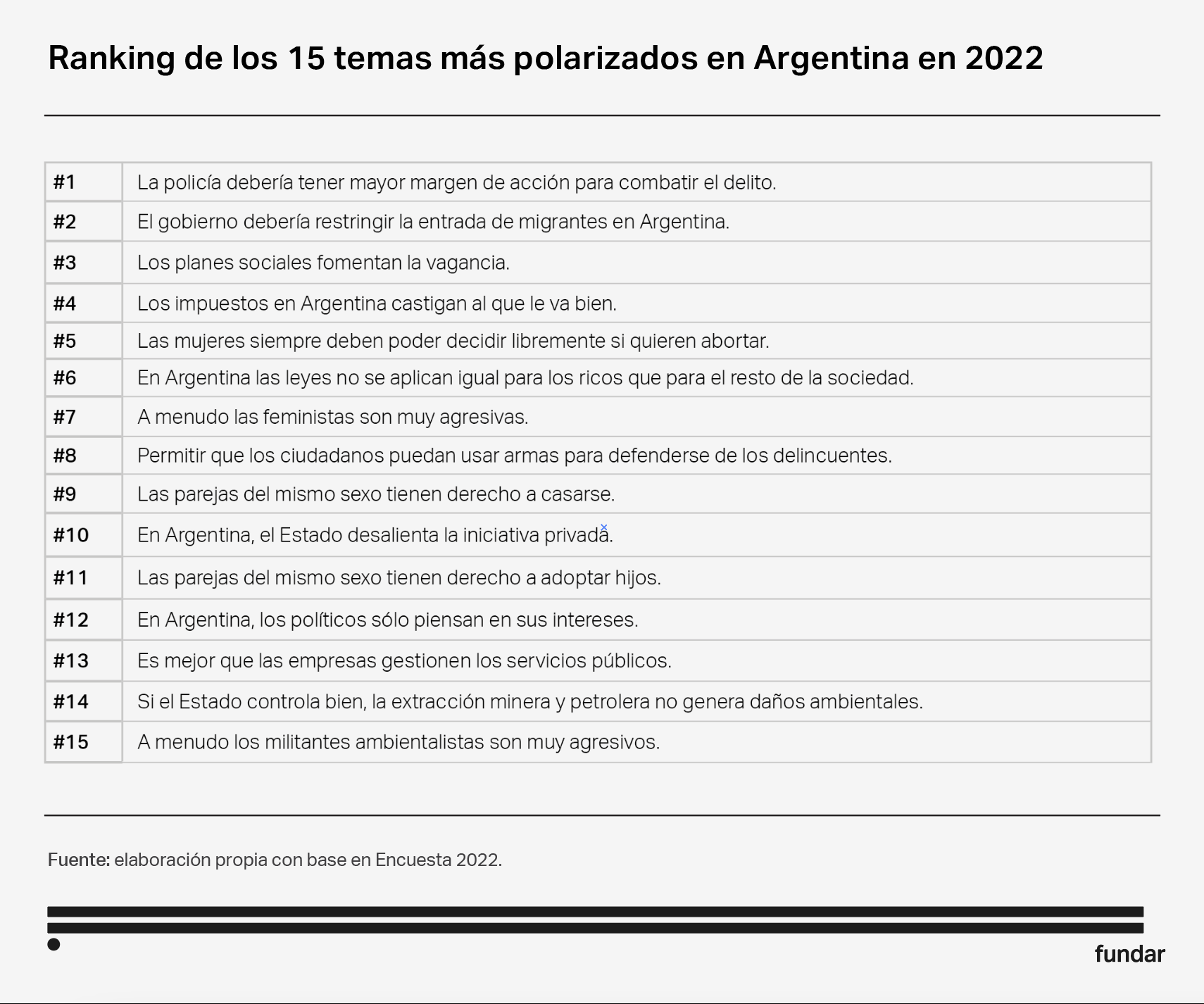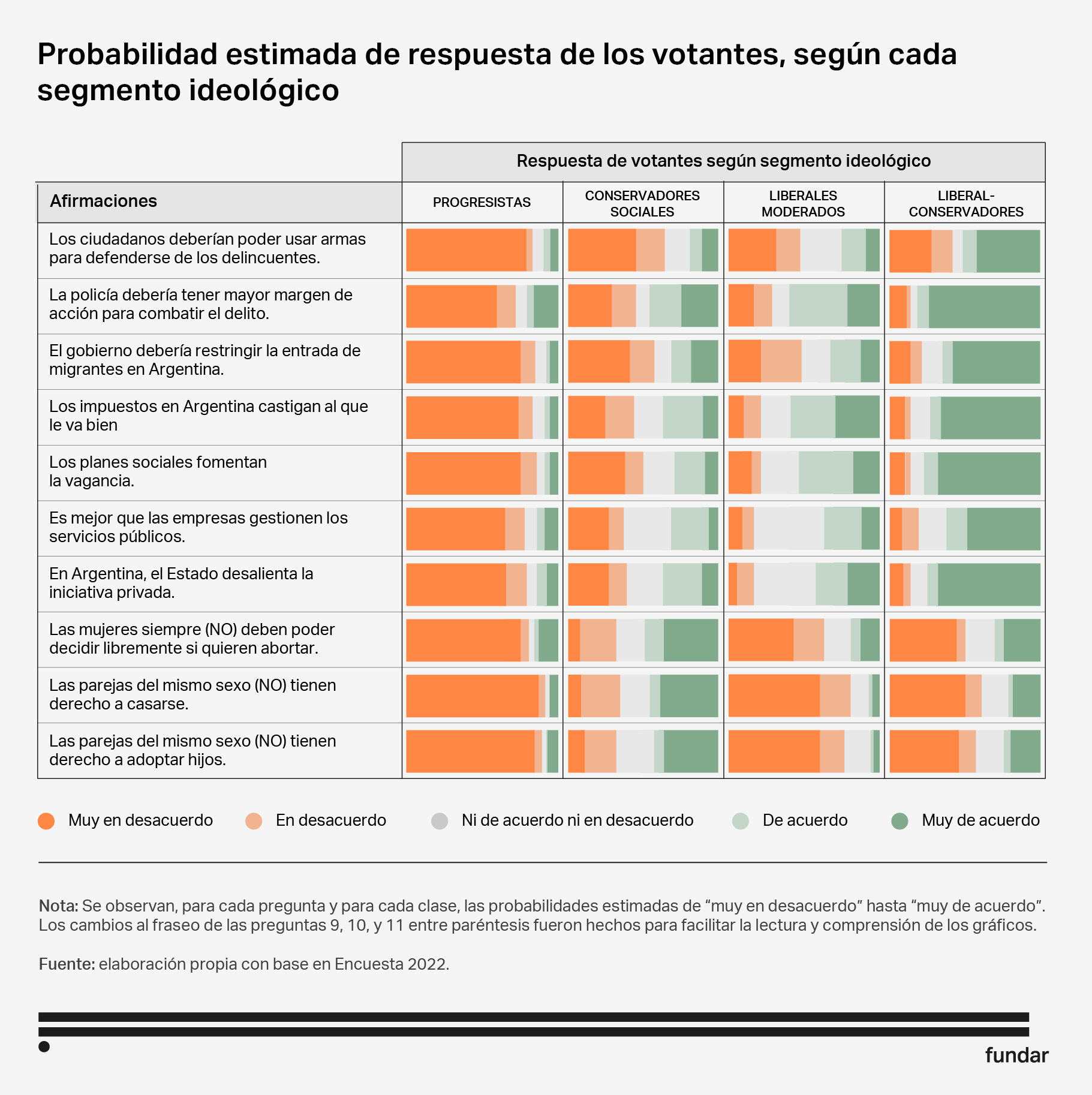Among the issues that divide Argentines are some directly related to the ballots: tell me what you think about taxes and social welfare programs, and I’ll tell you who you’re voting for. There are also issues that unite them, such as the disappointment at politics, others like the environment, that may even have the potential to build bridges. Researchers Gabriel Kessler and Gabriel Vommaro analyze data from opinion surveys and focus groups to identify the agendas that divide public opinion in this electoral year.
A fractured debate
It’s already common knowledge: Argentine society is polarized. This political division is linked to an ideological realignment, likely driven by the emergence of two major electoral coalitions since 2015: Frente de Todos (FdT) and Juntos por el Cambio (JxC).
Both coalitions hold opposing positions on central items in the political agenda. However, this polarization has limits. First, not all agendas generate identical levels of polarization; some issues create a deeper polarization than others. Second, there are significant discrepancies within the two coalitions among people who support either of each group’s main leaders. And even if the 2019 vote is a good predictor, the endorsement of the leading figures within both coalitions in 2023 is even more significant.
To identify the contentious issues that generate more rifts and capture the heterogeneity of voters supporting each faction, Gabriel Kessler and Gabriel Vommaro relied on an opinion survey on agenda topics conducted in 2022 to produce this report on the state of polarization in Argentine political debate leading up to the upcoming elections.
What are the issues that divide Argentinians?
Not all debates are equally polarized. To identify the most divisive issues, an indicator was constructed that captures the weight of extreme positions.

The most divisive issues were found in the fields of distributive policy and security. On the distributive side, more specifically, the position on taxes —are they or are they not a “punishment” for those who “do well”— and social subsidies —whether to maintain them permanently or temporarily, or altogether eliminated— generate a clear division in Argentine society. This division responds to conflicting notions of justice: while those in favor of social benefits and taxes defend an idea of social justice based on the redistributive power of the State, those who believe that social plans “encourage laziness” and that taxes constitute “punishment” promote an idea of justice essentially based on individual effort.
The authors’ hypothesis is that these criteria are associated with frames of reference provided by the coalitions to which each one ascribes and follow a clear criterion in relation to the vote. Frente de Todos voters consider social subsidies an indispensable tool to aid most disadvantaged sectors, while Juntos por el Cambio voters see social plans as vote encouragement mechanisms that undermine the culture of work.
Taxes also split opinions. While for JxC voters, the creation or increase of taxes constitutes a punishment for entrepreneurs; FdT voters see them as a tool to rebalance the unequal distribution of wealth.
The same holds true as for the issue of crime: more progressive approaches favor tackling crime by addressing its social roots, which are clearly at odds with more punitive approaches arguing that crime must be fought with harsher sentences.
What drives the vote?
The vote is the main predictor of opinions, followed by age, educational level and type of employment (public or private sector).
Polarization in Argentina has strong social drivers: the higher the educational level, the greater the preference for JxC candidates. In turn, there are differences in each class, mainly associated with work in the public or private sector. These were deepened by the COVID-19 pandemic, when private sector workers (in particular, the self-employed, informal or formal workers) found it harder to maintain their income level and had less access to state aid.
Young people are more progressive on gender issues than older generations, but they are also more punitive (in favor of carrying weapons, the death penalty). In addition, they show a greater contempt for political elites, which could explain their greater inclination for anti-establishment political positions than other age segments.
The four sides of the divide
Broadly speaking, the most forceful expression of the political polarization of voters follows the bi-coalitional logic of the electoral run, i.e. “liberals” versus “conservatives”. However, there are also differences within each of the two coalitions.
Based on their positions on the different agendas, four groups of voters were identified: “liberals”, “social conservatives”, “moderate liberals” and “liberal-conservatives”.
| Liberals have positions more consistently on the left of the political spectrum on all agendas: they reject punitive approaches to crime, support social subsidies and taxes, as well as state intervention in the economy and state ownership of businesses; they also advocate for increased recognition of sexual, gender and reproductive rights. |
| Social conservatives are, after progressives, those more in favor of redistribution and state intervention. They also have less punitive positions than the other two segments on crime-related issues. On the other hand, they are the most conservative on the cultural agenda, with the highest rates of rejection of abortion, equal marriage and adoption by same-sex couples. |
| Moderate liberals are, after progressives, the most favorable to advances in sexual, gender and reproductive rights, but hold punitive positions on crime, disagree more with distributive policies and are critical of state intervention, although not as strongly as the liberal-conservative group. |
| Liberal-conservatives have markedly punitive positions on crime, are clearly anti-distributive and critical of the state, but moderate on cultural agenda issues. |
Note: While the intermediate groups, so to speak, are an accurate reflection of the traditional average voters of the major parties, the segments at the extremes are still ideologically aligned with the core programs of both coalitions: Kirchnerism (FdT) and PRO (JxC).

Liberals and liberal-conservatives constitute the polar classes, with scarce common ground between them. They show that the main issues dividing Argentine society are, as outlined earlier, wealth distribution and crime. They support the core ideas of the two opposing political groups vying for power. Sharply included towards one side or the other of the political spectrum, the two extreme groups are also the ones with the highest proportion of highly educated people.
The “intermediate” classes (social conservatives and moderate liberals), on the other hand, show less marked differences: they both favor, albeit with nuances, state intervention and moderately punitive positions on crime, while they have a marked disagreement on the cultural agenda (gender, diversity and abortion) and the distribution of wealth (subsidies and taxes).
What new insights do these data bring to the public discussion about polarization?
They suggest that polarization focuses on those issues that gain public attention long enough to consolidate positions on one side and, almost consequently, strengthen those of the opposing side. For an issue to acquire polarizing attention, both coalitions have to address it and elaborate a clear position on it. And it is the most antagonistic groups of each coalition that drag the intermediate groups.
There are issues of inter-coalition consensus, particularly those linked to gender, especially around LGBT rights. Abortion rights, as in most corners of the world, continues to arise significant rejection from various sectors, although it has not mobilized efforts against the law currently in force so far. In any case, recent international experience points to the need for caution.
There are issues of considerable strategic importance, such as environmental issues and exploitation of mining resources, which, despite sparking protests and mobilizations, have not yet drawn attention as divisive issues in the eyes of the public. According to the authors, this is due to the fact that neither of the two coalitions is monolithically actively engaging on this issue, which opens an opportunity to find consensus.

